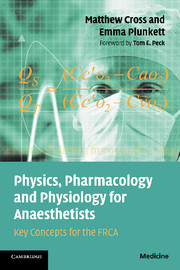Book contents
- Frontmatter
- Contents
- Acknowledgements
- Preface
- Foreword
- Introduction
- Section 1 Mathematical principles
- Section 2 Physical principles
- Simple mechanics
- The gas laws
- Laminar flow
- Turbulent flow
- Bernoulli, Venturi and Coanda
- Heat and temperature
- Humidity
- Latent heat
- Isotherms
- Solubility and diffusion
- Osmosis and colligative properties
- Resistors and resistance
- Capacitors and capacitance
- Inductors and inductance
- Defibrillators
- Resonance and damping
- Pulse oximetry
- Capnography
- Absorption of carbon dioxide
- Cardiac output measurement
- The Doppler effect
- Neuromuscular blockade monitoring
- Surgical diathermy
- Cleaning, disinfection and sterilization
- Section 3 Pharmacological principles
- Section 4 Pharmacodynamics
- Section 5 Pharmacokinetics
- Section 6 Respiratory physiology
- Section 7 Cardiovascular physiology
- Section 8 Renal physiology
- Section 9 Neurophysiology
- Section 10 Statistical principles
- Appendix
- Index
Heat and temperature
Published online by Cambridge University Press: 15 January 2010
- Frontmatter
- Contents
- Acknowledgements
- Preface
- Foreword
- Introduction
- Section 1 Mathematical principles
- Section 2 Physical principles
- Simple mechanics
- The gas laws
- Laminar flow
- Turbulent flow
- Bernoulli, Venturi and Coanda
- Heat and temperature
- Humidity
- Latent heat
- Isotherms
- Solubility and diffusion
- Osmosis and colligative properties
- Resistors and resistance
- Capacitors and capacitance
- Inductors and inductance
- Defibrillators
- Resonance and damping
- Pulse oximetry
- Capnography
- Absorption of carbon dioxide
- Cardiac output measurement
- The Doppler effect
- Neuromuscular blockade monitoring
- Surgical diathermy
- Cleaning, disinfection and sterilization
- Section 3 Pharmacological principles
- Section 4 Pharmacodynamics
- Section 5 Pharmacokinetics
- Section 6 Respiratory physiology
- Section 7 Cardiovascular physiology
- Section 8 Renal physiology
- Section 9 Neurophysiology
- Section 10 Statistical principles
- Appendix
- Index
Summary
Heat
The form of energy that passes between two samples owing to the difference in their temperatures.
Temperature
The property of matter which determines whether heat energy will flow to or from another object of a different temperature.
Heat energy will flow from an object of a high temperature to an object of a lower temperature. An object with a high temperature does not necessarily contain more heat energy than one with a lower temperature as the temperature change per unit of heat energy supplied will depend upon the specific heat capacity of the object in question.
Triple point
The temperature at which all three phases of water – solid, liquid and gas – are in equilibrium at 611.73 Pa. It occurs at 0.01 °C.
Kelvin
One kelvin is equal to 1/273.16 of the thermodynamic triple point of water. A change in temperature of 1 K is equal in magnitude to that of 1 °C.
Kelvin must be used when performing calculations with temperature. For example, the volume of gas at 20 °C is not double that at 10 °C: 10 °C is 283.15 K so the temperature must rise to 566.30 K (293.15 °C) before the volume of gas will double.
Celsius/centigrade
Celsius (formerly called the degree centigrade) is a common measure of temperature in which a change of 1 °C is equal in magnitude to a change of 1 K. To convert absolute temperatures given in degrees celsius to kelvin, you must add 273.15. For example 20 °C = 293.15 K.
- Type
- Chapter
- Information
- Physics, Pharmacology and Physiology for AnaesthetistsKey Concepts for the FRCA, pp. 30 - 32Publisher: Cambridge University PressPrint publication year: 2008



